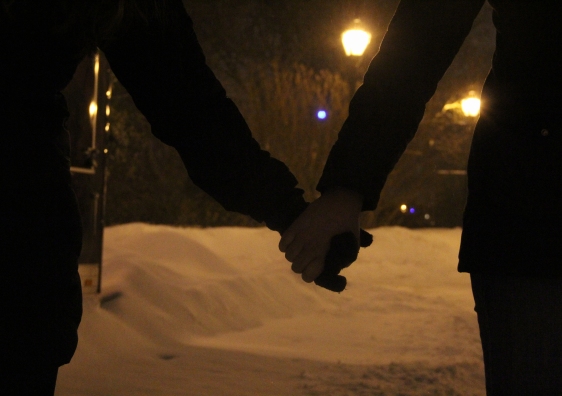
The cold weather could be a major factor as to why so many people want to be in relationships in the winter. Kellyn Simpkins/The Fordham Ram
By Elizabeth Forger
Last Tuesday, I was strolling the halls of Keating and saw through one of the classroom doors a guy who, this past September, exchanged numbers with me on a night out. After the initial meeting, he texted me a few times over the semester looking to get together, but my schedule and workload led me to decline each time. However, that Tuesday evening, while my friends were deliberating what they would wear out into the frigid February air, I picked up my phone and asked the last semester guy if he wanted to hang out.
I attribute my sudden renewal of interest to the influence of “cuffing season.” Urban Dictionary defines this fifth season as a time “during the fall and winter months” when “people who would normally rather be single or promiscuous find themselves along with the rest of the world desiring to be ‘cuffed’ or tied down by a serious relationship.”
The idea that climatic conditions are a powerful determinant could discredit winter relationships. Are you and your partner dating because of your genuine desire for each other, or because of the seven-day forecast?
I interviewed four female and four male sophomores to confirm this phenomenon’s existence. Although some of the interviewees were unaware of the term “cuffing season,” all agreed that they were more inclined to settle down during winter months than in summer ones.
“In the beginning of the year I didn’t want anything,” Gabby McGovern, FCRH ‘17 admitted. “But, now that it’s winter, the cold definitely does something where you just want to stay in with that special somebody.”
Evin Daniels, FCRH ’17, agreed, “When the cold hits, people start to get lonely.” However, not all interviewees readily ascribed their inclination to settle down to dropping temperatures. Some attributed it to their maturation over the course of college. “After three semesters of college,” Eric Strazza, FCRH ’17, said, “people are tired of going out all the time and hooking up with random people.”
“They have gotten it all out of their system,” he explained.
While there are many reasons to want a relationship, anthropological evidence indicates that eagerness to settle down can be connected to colder temperatures.
Dr. Wendy Walsh, a clinical psychologist who specializes in the love, sex and gender roles, credited the desire to be “cuffed” during the colder months to human nature. In the past, when resources were scarce in colder temperatures, survival was more likely in the winter if “you were in a pack” or “if you were coupled up.” Hence, “cuffing” was a mode of survival.
This historical behavior has shaped our present dating strategies. Zoosk, an online dating site, found that there is a 56 percent increase in messages and a 31 percent increase in profiles viewed on snowy days in NYC.
Furthermore, babycenter.com determined that the most births occur in September, nine months after January’s notoriously brutal temperatures keep couples locked indoors. Thus, “cuffing season” existed before the present day hook-up culture and continues to exist everywhere, not just within the university setting.
But, the weather’s influential power on whether or not two people enter into a relationship undermines the traditional idea that the decision to enter into a relationship is based on desire between two people. If a relationship wants to remain healthy and last longer than the average fling, there needs to be a real connection between the two partners, instead of the desire to “cuff” someone. There needs to be sincerity; would the guy who asked you out in January have asked you out in August?
While monogamous traditions in society see desire as persistent and stagnant, there is mobility. Rene Girard, a French post-structuralist critic, contended that we learn to desire through imitation so that our desire is “produced in response to the desire of another.” Thus, human desire is a product of what society shows us about desire. Contrary to the traditional, personal definition of desire, Bennett and Royle show that social constructions and human habits influence who and what we desire.
Given this, it is possible that your special someone only initiated contact under the spell of “cuffing season.” But, in order to continue any relationship beyond the initial meeting requires a connection that could weather any season. An initial desire is needed to spark a connection between two people, but there must be a strong personal connection that transcends the powers of “cuffing season” to maintain that relationship.
So, although a chance of snow is not the most romantic catalyst, any winter relationship has the chance to blossom like spring flowers when the snow begins to thaw. As for the last semester guy, time will tell if it can survive the first April shower.
